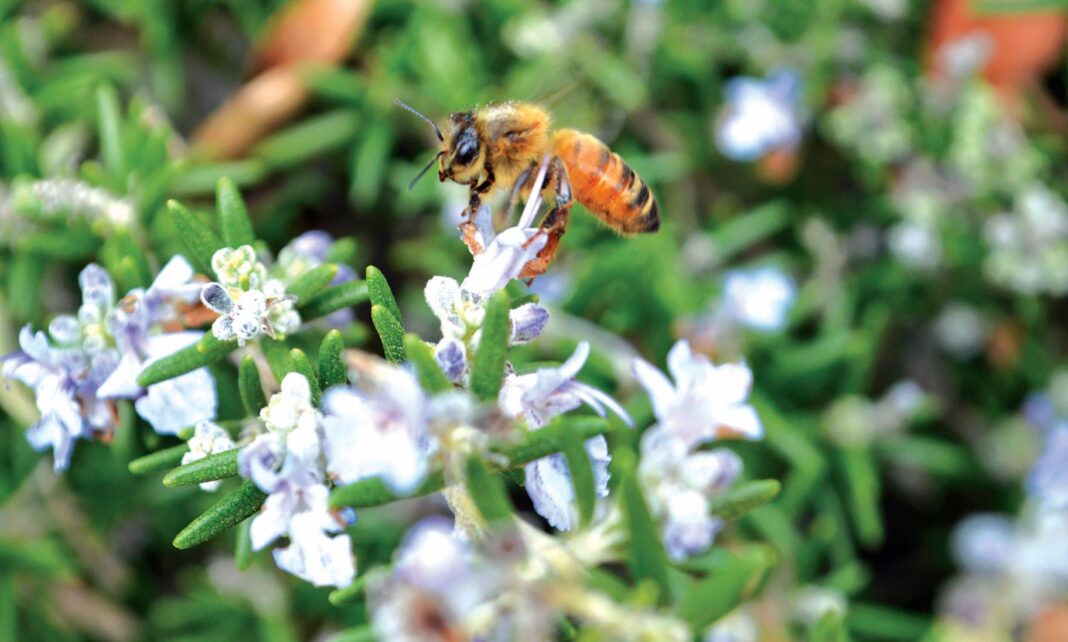Traditionally, rosemary was a symbol of love, loyalty and friendship. This plant may be considered common and hardy, but it should never be overlooked!
This wonder plant’s qualities are seemingly endless. Rosemary (Rosmarinus officinalis, as well as other lesser-known species), is a perennial Mediterranean shrub up to 1.5m with strongly aromatic foliage and mauve flowers in spring and summer. There are also white, pink and blue flowering varieties of differing sizes and habits available, including ground-covering.
Rosemary is drought, sun and heat tolerant, perfect for Canberra gardens. Depending on the species grown, they are useful as general bedding plants, border plants, informal hedges or ground covers. They prefer neutral to slightly alkaline soils, so the addition of dolomite may be needed in Canberra’s often acidic soils.
With its distinct and strong aroma, rosemary is useful as a companion plant as it confuses pests. Planting rosemary amongst vulnerable plants disguises them from pests which rely on sight to locate target plants.
Rosemary’s allure to bees is also well known, but did you know that butterflies and some bird species also feast on their flowers? I certainly didn’t until I saw rosellas doing exactly that!
Amongst its many applications, both dried and fresh rosemary leaves are used to impart its distinct flavour to meat dishes, soups, stews and roasted vegetables. And not so commonly, it adds a unique twist to sweet dishes such as cakes and preserves.
Rosemary also has anti-fungal, anti-bacterial, anti-inflammatory and healing qualities. It can be applied externally to assist in the healing of superficial wounds and mouth infections, relieve symptoms of bruises and sprains, and help preserve skin and teeth.
Dried rosemary can be used as an incense to help purify the air and was considered in some circles to ward off evil spirits. If that isn’t enough to sway you, rosemary contains several phytochemicals including camphor, a handy protection against moths on clothes and paper.
Propagation is possible by seed but much easier by semi-hardwood cuttings towards the end of our spring and autumn growing seasons. Material is best collected first thing in the morning and should be free of flowers if possible. Go for 5cm length and remove two-thirds of the foliage. Stick approximately one-third of the cutting below the surface. Use a quality propagation mix and rooting hormone. Roots will begin to form between six and 12 weeks, depending on the time of year and growing conditions.
Rosemary, olive oil and pear muffins
Makes 12
Ingredients
- 1 1/2 cups self-raising flour, sifted
- 3/4 cup self-raising wholemeal or spelt flour, sifted
- 1/4 tsp bicarb soda
- 3/4 cup castor sugar
- 1 1/4 cups fruity olive oil
- 1 tsp vanilla essence
- 3 eggs
- 4 small pears, fresh or preserved and coarsely chopped
- 2 tsp chopped rosemary leaves
- 1/4 cup currants, soaked in brandy overnight
Method
- Pre-heat oven to 180oC.
- Combine dry ingredients.
- In separate bowl, beat wet ingredients except pear and brandy-soaked currants.
- Gently combine wet ingredients with dry ingredients.
- Fold through brandy-soaked currants and chopped pears.
- Spoon batter into greased muffin tins and cook until golden and a skewer comes out cleanly, around 20 minutes.
For more:



